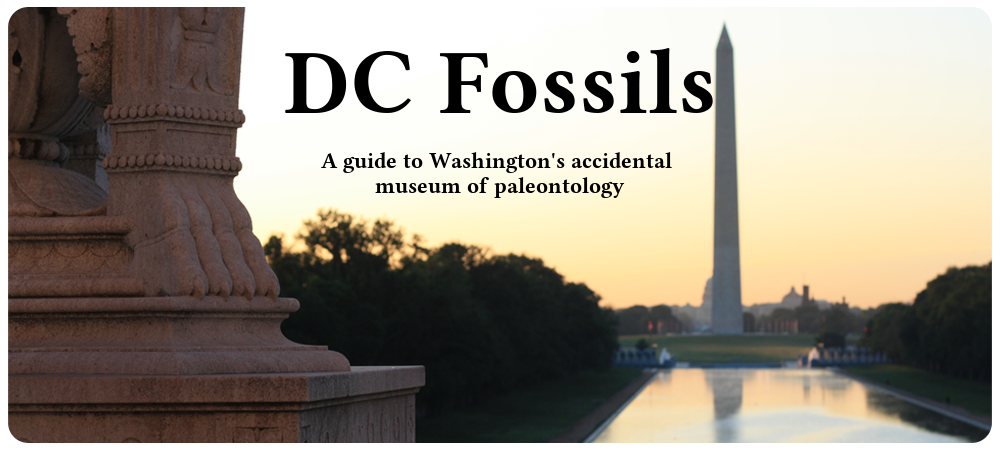Introduction
Origins of the Red Alicante Stone in Jurassic Spain
About Belemnites
About Ammonites
Fossil Identification Tips: How to Distinguish an Ammonite from a Gastropod
About the Reptile House
Acknowledgments and Sources
From the National Zoo’s entrance on Connecticut Ave., the Olmstead Walk winds down the broad slope of the Rock Creek valley. To reach this Gallery, walk down this path, past the new (as of 2006) Asian Trail on the right, and past the cheetahs on the left. Downhill stands the core of the Zoo’s great early twentieth century exhibit buildings. First, on the right one passes the Elephant House (c. 1934). Then on the left, one passes the red brick Small Mammal House (c. 1937), a simpler and more modest building. At the farthest end of this stretch stands the Monkey House (1906) (more recently renamed “the Think Tank”), which is surmounted by bears, foxes and bobcats.
Just past the concrete Great Ape House, and just uphill from the Monkey House, stands the most striking Zoo building, the Reptile House (1931).

The Reptile House was heralded as a modern scientific facility at its opening, but the modern visitor is struck most by its ornate features. Bright ceiling tiles cover the roof, accented by colorful, patterned bricks in the walls. Its most intriguing feature is the elaborate architectural confection surrounding the entrance:
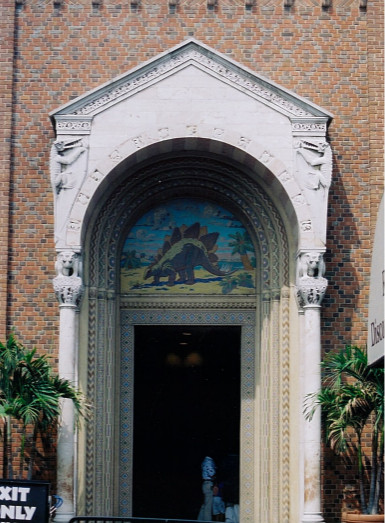
The entrance is framed by an arched stone portal more than 25 feet high. Twin columns flank the entrance, supported by stone turtles:

Stone toads surmount the columns, and above them whimsically carved reptiles climb the corners of the portal:


The bronze doors have snake-like handles and are surrounded by complex and colorful brickwork.
The portal’s centerpiece is a large tile mosaic of a dinosaur – Stegosaurus:
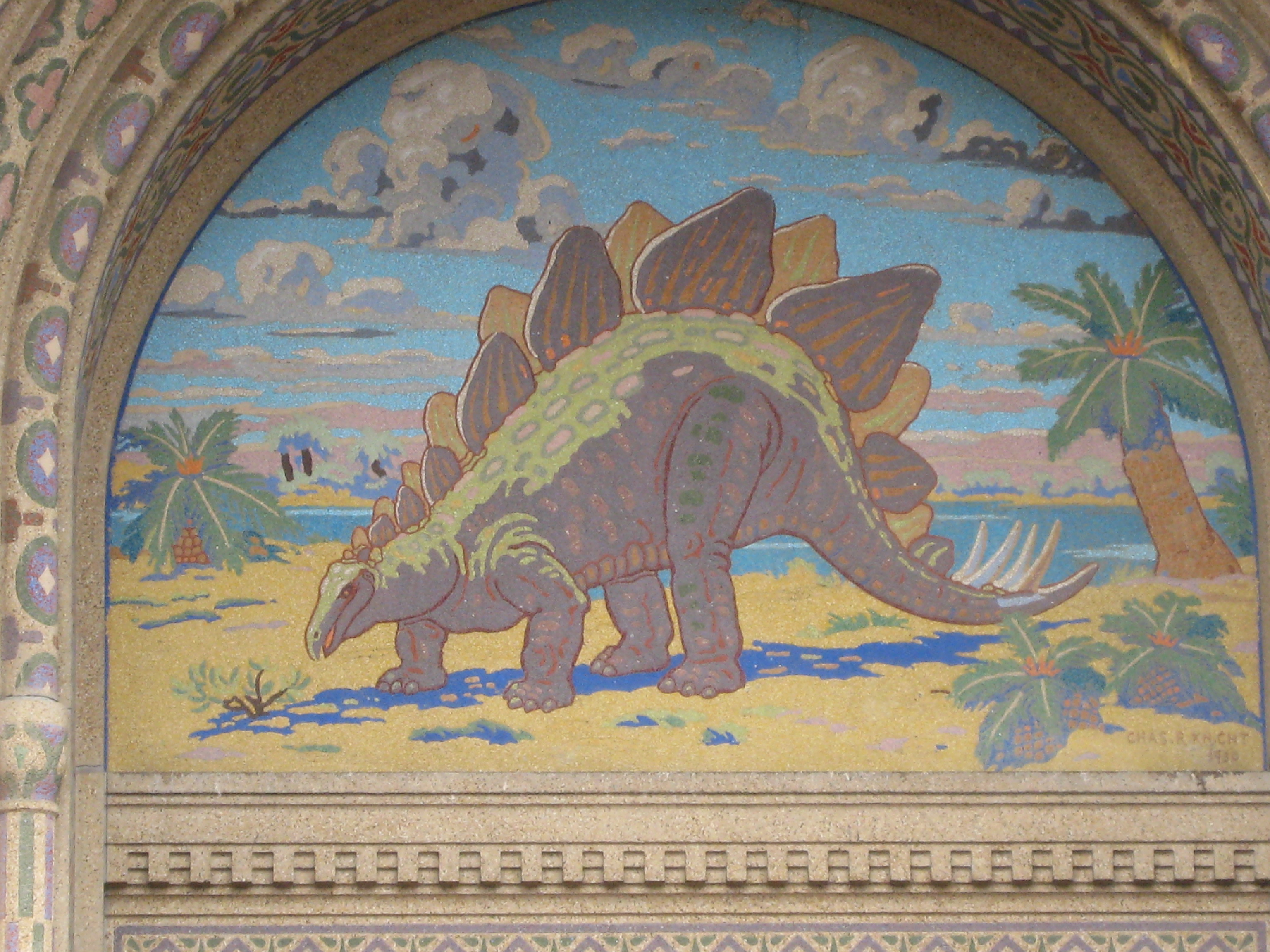 [“
[“
Presumably, the Stegosaurus was meant to represent the mighty dinosaurian forebears of the modern reptiles within. These architectural features are well-known and are amply described in works on Zoo architecture.
Less well-known – indeed, seemingly forgotten – is the supporting symbolic role of the stone in the pillars and doorframe, stone that complements the dinosaur mosaic.
Take a close look at the left hand pillar, on the left side, about four feet from the ground:

This coiled shape is from an ammonite shell – ammonites were tentacled cephalopods. Now take a close look at the pale stone in the pilaster directly behind the pillar, and you can see some cigar-like shapes, some shapes like long, tapered “v”s:
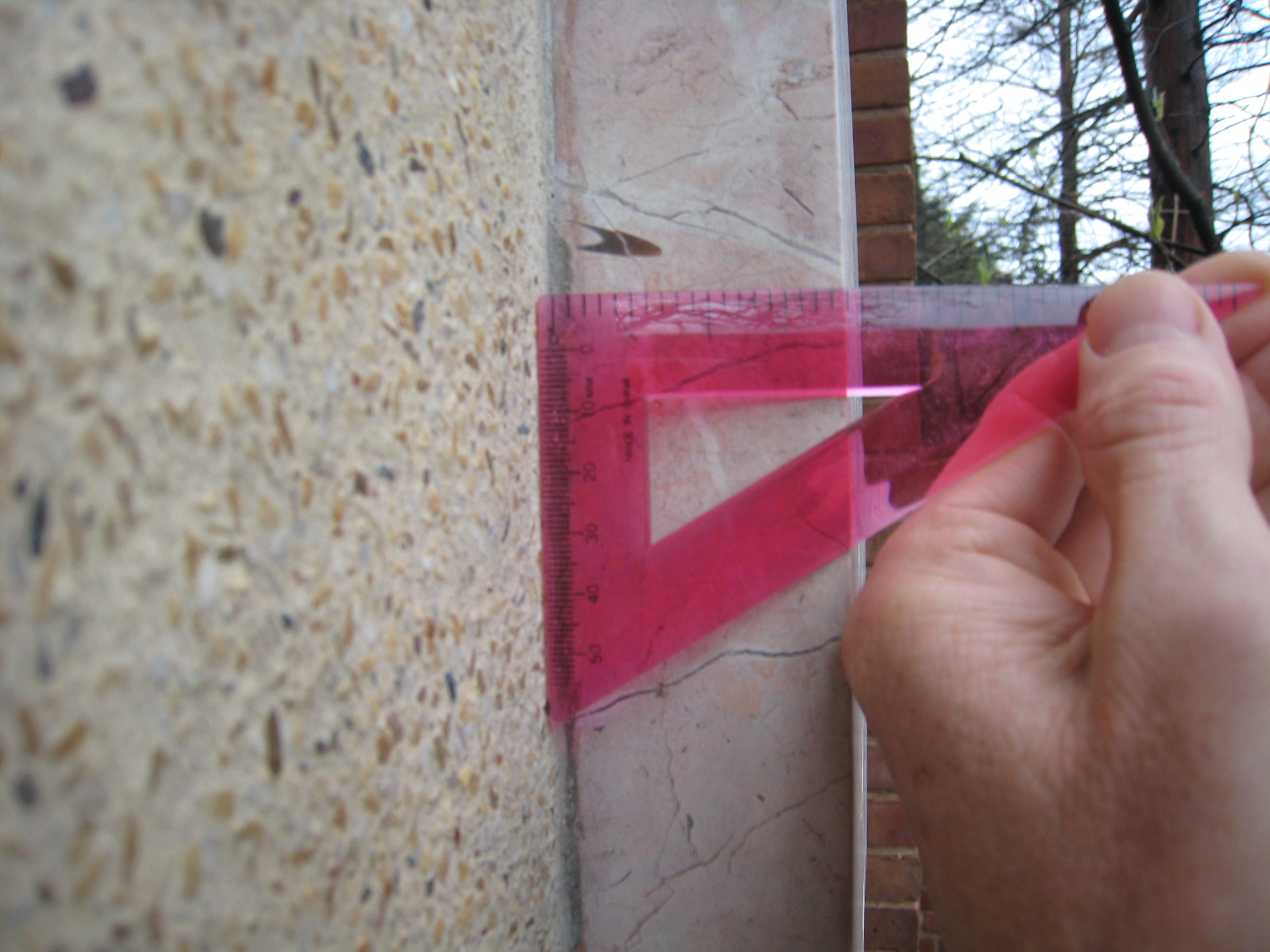


These shapes are belemnite shells – they belonged to an extinct, squid-like animal. The fossils are in a limestone commercially known as “Red Alicante Marble” from a geological formation dating to the Upper Jurassic period, between approximately 160 and 150 million years ago. The fossilized animals would therefore have been contemporaries of the Stegosaurus in the mosaic. It may be coincidence. More plausibly, the stone in the reptile portal represents a rare instance in which the architects consciously chose a building stone in order to present fossils of a particular era. The modern consensus is that modern reptiles did not evolve from the dinosaurs, but rather that both dinosaurs and modern reptiles share a common ancestor. Nonetheless, the architects’ intriguing effort to link symbolically the past and present in the very structure of the Reptile House make it particularly instructive Gallery in the Washington’s Accidental Museum.
Origins of the Red Alicante Stone in Jurassic Spain
The area that is now Spain was quite different in late Jurassic times. A continental land mass lay atop the Iberian Plate – the Iberian Massif – that was smaller in area than the present boundaries of Spain. Bodies of water separated the land mass from the Laurentian (proto-North American) land mass to the west, and from the larger European plate to the east. South stretched the Tethys Ocean, a predecessor to today’s Mediterranean Sea.
Alicante lay under a pelagic, or fairly deep, marine body of water. Large deposits of calcium-rich sediments collected at the sea bottom, primarily formed by the remains of pelecypod (clam-like) shells. Included in the sediments, in places, were the whole shells of free-swimming cephalopods, including belemnites and ammonites. Evidence of the pelecypod shells cannot be seen with the unaided eye, but the cephalopod fossils are strikingly clear.
Belemnites, or belemnoids, were the first subclass of cephalopods to shed the hard outer shell characteristic of the earlier nautiloids and the first ammonites. They still retained a smaller, reduced shell, covered by a fleshy mantle, which widened into lateral fins that helped them to steer and change depth.
Belemnites are believed to have been fast swimmers that resembled modern in appearance and behavior. Belemnites swam by jetting water through a funnel; they had ink sacs to blind pursuers; and unlike the nautiloids, belemnites’ eyes used lenses rather than pinholes. Belemnites sometimes moved in schools.
Significant differences existed, however. Belemnite’ ten tentacles had hooks rather than suction cups; and fractures in their shells suggest that they often bumped into obstacles as they squirted backwards. Over time, belemnites developed as outer guard a bullet-shaped rostrum to protect the inner shell, behind and slightly around it.
 “
“
(from the Delaware Geological Survey, http://www.udel.edu/dgs/Education/stfossil.html, drawn after Moore, Lalicker, and Fisher, 1952, Invertebrate Fossils: New York, McGraw-Hill Book Company)
It is the hardy rostrum that typically survives in most fossil assemblages, including the Red Alicante stone.
Belemnites developed during the Mississippian period, became numerous during the late Triassic, and reached their height during the Jurassic and Cretaceous. They declined after the end of the Mesozoic, surviving in sharply diminished numbers until extinction in the Eocene. Meanwhile, belemnites gave rise to the dominant modern cephalopod types. In the Jurassic, related subclasses evolved from the belemnites, including the early, direct ancestors of modern squids, losing their shells.
Ammonites are among the most well-known fossil shells. Their beautifully preserved, complex cross sections adorn many a stone bookend. Unlike most other fossils, whose names stem from utilitarian Greek or Latin words relating to their form, the name “ammonites” is an allusion to Egyptian mythology. The term “Ammon’s stones” was given to fossils whose curling shapes suggested rams’ horns – characteristic of the Egyptian god Ammon.
Like nautiloids and belemnites, ammonoids are a subclass of cephalopods that had well-developed eyes, tentacles, and the ability to move by jetting water, aided by a buoyant shell. The specimens in the Red Alicante stone are a few inches across, a common size, but some ammonite species reached nearly six feet in diameter.
Ammonites all had coiled shells, composed of a series of chambers separated by walls, or septa, and connected by a tube stretching from the living body in the first chamber, to the end of the shell (the ‘siphuncle”). Although this basic structure resembles that of the nautiloids (discussed in Gallery 4), important differences appear. Many ammonites had curved and patterned walls, or “septa” between the chambers, and distinctive “sutures” where the septa met the outer shell. Many ammonites had hard plates or similar structures to seal off the end of the shell when the body was wholly inside, and had beaklike jaws, and an ink sac.
Note the clearly visible, double-curved, parallel septa in the ammonite below. You can also clearly see the distinctive suture where the septa meet the outer shell:
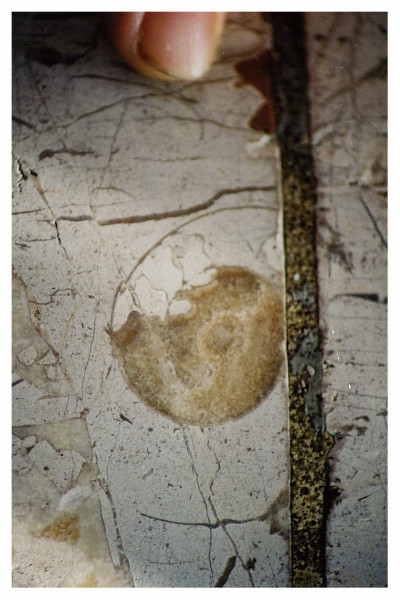
Because of their worldwide distribution and rapid evolution into many species, ammonites are a particularly useful fossil for identifying the date of rocks formed during the Mesozoic period.
Ammonites became extinct at the end of the Cretaceous, concurrently with the end of the dinosaurs, so their presence under the mosaic of the Stegosaurus is especially fitting.
Fossil Identification Tips: How to Distinguish an Ammonite from a Gastropod
Visitors to Gallery 3, with its coiled Maclurites shells may be perplexed by the seeming similarity of the coiled Maclurites shell to the coiled ammonite shell here in Gallery 8.

Fear not. The gastropod shell need not be confused with the ammonite or coiled nautiloid shells. Remember two easydistinctions visible to the unaided eye:
1. The ammonite shell has chambers, separated by septa. Most gastropod shells have no chambers and no septa, and those that do have chambers have irregular spacing between septa; the coiled shell surrounds a single uninterrupted chamber.
2. The ammonite shell has a siphuncle (although not always visible), connecting the chambers; the gastropod shell never has a siphuncle.
These tips are courtesy of a valuable aid to fossil hunters, Otto Majeske’s 1969 “Recognition of Fossil Fragments in Rocks and Thin Sections.”
The National Zoo is a splendid and storied part of the Smithsonian system. It lures vast numbers of visitors to a location miles away from the city’s monumental core. But the Zoo was not always so well equipped. Founded as a Smithsonian project in 1890, for decades the Zoo housed a growing array of animals in less than impressive quarters. Following the appointment of Dr. William Mann as Director in 1925, however, funds became increasingly available for building. Construction of the Bird House (1927) was followed by the Reptile House in 1930, and then a series of new buildings, enriched by the Public Works of Art Project, through the 1930s.
Dr. Mann, a genial and exuberant director, chose to make the Reptile House first on his list of major new buildings, as he stated, “because it was, we thought, the hardest to get.” He noted that the very idea of lavishing sums “on a building in which to house snakes at first met with violent opposition.” Nonetheless, money was appropriated, and no pains were spared in the design of the new structure. Dr. Mann and Albert L. Harris, the municipal architect of the District of Columbia, went on a 10-week tour of European zoos to determine the best features for a reptile house. In an article published in a popular science magazine, Dr. Mann wrote at length about the goals that they sought to meet in the design: engineering, exhibition, and functionality.
Yet, the aesthetic and allegorical elements of the Reptile Portal were not accidental. The Smithsonian also retained a remarkable artist to assist in the Reptile House project: Charles Knight. Mr. Knight, a sculptor, author and lecturer, worked on prehistoric restoration at the Field Museum of Natural History. Mr. Knight became famous as an illustrator of dinosaurs and other extinct animals in books and other artworks that were widely influential. Some of those works remain in publication today. Charles Knight designed the Stegosaurus mosaic.
The extensive symbolism of the Reptile Portal makes it unlikely that the architects accidentally chose to add a stone displaying fossils of creatures contemporary with the Stegosaurus. Mr. Knight clearly believed in the importance of linking the current zoo inhabitants with their evolutionary predecessors, as shown by his later bas relief sculptures pairing extinct and modern pachyderms and other species in the Elephant House. Intriguingly, by 1930, Charles Knight had just finished lengthy visits to Spain to study prehistory. Perhaps it is only chance that upon Mr. Knight’s return from trips to Spain, the architects chose a Spanish Jurassic stone to accompany his dinosaur mosaic. It seems more likely that the designers of the portal wished to pair the fossils and the mosaic.
Acknowledgments and Sources[1]
Identification of the fossils. The Smithsonian Archives contain the original drawings for the Reptile House, which indicate that the stone in the front columns and framing the doorway are “Rojo Alicante.” See Archives Record Unit 92, Drawing No. 135. Rojo Alicante is a commercial stone that is still marketed and catalogue pictures and descriptions match the stone in the Reptile House. The “Red Alicante” is identified as being “an upper Jurassic pelagic limestone,” from La Romana, (Alicante, Spain), in “The Application of SEM Analysis in Evaluating Surface Alteration of Building Stone Induced by Experimental Testing in a Kesternick Chamber, Application to the Red Alicante Commercial Marble,” Bernabeu, A., Benevente, D., Garcia del Cura, M.A., & Ordonez, S., copy provided by A. Bernabeu, at p. 2 (“Bernabeu”). Dr. Royal Mapes, Ohio University, confirmed that the straight cephalopod fossils are the rostra of belemnites, personal communication.
About the Geological history of Spain in the Jurassic. Geology of Spain, Gibbons, W. and Moreno, T. (2002) at 4, 222-235.
About ammonites and belemnites. The Fossil Book, A Record of Prehistoric Life, Carroll Lane Fenton and Mildred Adams Fenton (rev. ed., 1989) at 291-294 (belemnites), 281 (ammonites).
Fossil Tips: Majeske, Otto P., “Recognition of Fossil Fragments in Rocks and Thin Sections,” International Sedimentary. Petrographical Series, vol. 13, E.J. Brill (Leiden, 1969) 101.
About the Reptile House. Information about the various Zoo buildings, including the Reptile House, is primarily drawn from The Outdoor Sculpture of Washington, D.C., James M. Goode (Smithsonian Press 1974) at 111-117. Details about the origins of the Reptile House come from “A New Home for Reptiles,” by William A. Mann, in Science Today, A Layman’s Handbook of Recent Discoveries, ed. Watson Davis, (Harcourt, Brace and Co. 1931). Various press releases and articles in the Washington Post were also reviewed, including, “New Zoo Building to Be Luxurious Home for Snakes,” Oct. 19, 1930, “New Reptile House Draws Zoo Crowds,” Mar. 2, 1931. For information on Charles Knight, the artist, see http://www.charlesrknight.com/. Dr. Cynthia Field contributed information on the Zoo’s architectural context.
[1] Where this website cites specific internet page addresses, they are typically the addresses used by the author in researching and writing this discussion – a process taking several years. Unfortunately, in the meantime a number of the specific addresses have changed, and will continue to change, rendering some of these addresses ineffective as links. Readers should be able to find the material by searching for the proper name of the cited article or material on a search engine.
